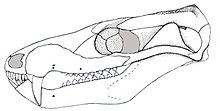Brasilodon
|
Brasilodon Temporal range: Late Triassic |
|
|---|---|
 |
|
| Brasilodon Skull in Lateral View | |
| Scientific classification | |
| Kingdom: | Animalia |
| Phylum: | Chordata |
| Order: | Therapsida |
| Suborder: | Cynodontia |
| Family: | †Brasilodontidae |
| Genus: | †Brasilodon |
| Type species | |
|
†Brasilodon tetragonus Bonaparte, Martinelli, Schultz & Rubert, 2003 |
|
| Species | |
|
B. tetragonus (Bonaparte, 2003) |
|
B. tetragonus (Bonaparte, 2003)
B. quadrangularis (Bonaparte, 2003)
Brasilodon ("Brazil tooth") is an extinct genus of cynodont that lived during the Norian age of the Late Triassic Period, about 228 to 208.5 million years ago. The average length of Brasilodon is approximately 12 cm and weighed about 20 grams.The average size of this cynodont species is about the size of extant mice. Brasilodontids are most likely insectivores due to their teeth. The two species in this genus are B. tetragonus and B. quadrangularis, two very small cynodonts belonging to the family Brasilodontidae.
Brasilodon is a genus of small derived cynodont that exhibits many mammalian features including a secondary palate, symmetrical tooth development, and more developed sense of hearing than other cynodonts. The study of Brasilodons shows that the expansion of advanced cynodonts with mammalian features occurred in several species that still retained many primitive features.
Skull size in Brasilidontids varies from individual to individual about 35-40%, and is about 20% larger than Brasilitherium, the other genus in the family Brasilodontidae. Brasilodon species lack a prefrontal bone, postorbital bone, and postorbital bar, which is seen in most other Probainognathians. Some derived features shown in Brasilodon include: reduced postdentary bones, nasal-frontal bone contact on the lateral sides, reduced canines close to the size of the last incisor, and the vascular features of their "stapedial recess". The well developed stapedial process, as well as the presence of several foramina in Brasilodon indicates that the middle ear of Brasilodontids was another feature showing that it is a more derived Probainognathian. The interpterygoid vacuity seen in Brasilodontids is considered to be possibly derived or a reversed character of the primary palate found in mammals, which extends from the choana to the interpterygoid vacuities. The presence of a secondary palate shows another derived feature found in Brasilodon, and the posterior end of the secondary osseous palate extends posteriorly to the last postcanine.
Brasilodon quadrangularis is characterized by quadrangular upper and lower postcanines, which are secured to the jaw by ossified periodontal ligament in the root. Each tooth row contains 6-8 upper postcanines and 8-9 lower postcanines; there is little morphological variation to be seen in the upper tooth rows, while the lower tooth rows exhibit more variable morphology. The upper postcanines are considerably smaller than lower postcanines, a condition observed in many Probainognathians.Brasilodon can be differentiated from Brasilitherium by its more derived lower postcanines. This consists of a prominent central cusp, an anterior accessory cusp, and a posterior accessory cusp, resulting in a symmetrical distribution (this trait is more derived than any other Probainognathian). The postcanines seen in Brasilitherium, on the other hand, has morganucondontid-like plan in lower postcanines. Due to the size of the diastema between canines and postcanines in the largest Brasilodontids, this shows that anterior postcanines were most likely lost faster than it was in Thrinaxodon (an early cynodont).
...
Wikipedia
